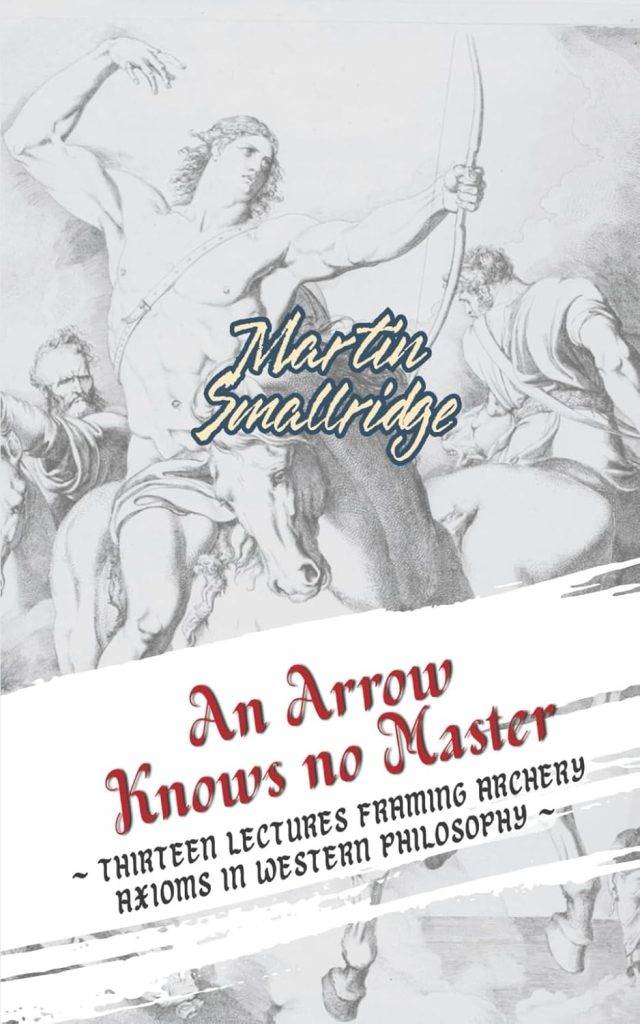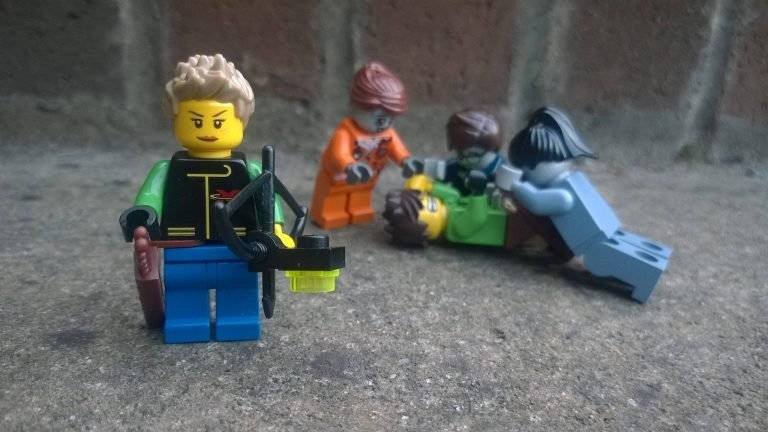
Time walks as my fiercest rival. It gathers more than it gifts and measures each hour with a strict hand, so I stepped straight through that pressure and wrote this book. The seed took hold two years ago as a modest framework for club life—ethical, philosophical, service-minded—and then the project grew its own breath. Books roll in like weather—sudden, pressing, charged with pure purpose—so a door swings, a chair skids, and a voice takes the room completely now. Western thought stands as the chosen ground for this work. Shelves already brim with strong readings that pair archery with Eastern lineages and many friends flourish along that current with grace; the Western channel answers the range through lived duty and civic care that rise directly from practice. I pictured old giants stepping onto the line, each with a bow in hand, each answering through the lens of a lived ethic. A stance emerges, a grip settles, a release travels across air, and an idea earns proof in the body.
I wrote as Martin Smallridge for the fields that shaped me—Portlaoise mornings under slate and glass, Wexford hedges rich with rook-cry and nettle sting, quarries where window-light strikes limestone grit into clean rectangles. The preface, “Striking Thought,” lays a contract upon the table: a field journal scented by grass and string wax shares one spine with lectures that carry hard questions without flinch. Scenes lead, arguments answer. An October peg holds a slick of rain and cold earth steadies the palm. Fletching brushes a shy breeze and the heart finds tempo at anchor. Those moments cross a scrubbed tabletop where reasoning sits upright: hands remember, eyes weigh consequence, breath gives measure, release seals the sentence.
A reader opens a page and a room assembles. A jug sweats on oak; chalk waits near a target face tacked to the wall. A question rises in the steam of tea—measure, habit, duty, choice, risk—each word shaped by a presence at the edge of vision. A grey-bearded host sets a cup down and touches the lip of the jug as if to mark proportion. Across the table a scholar draws two quick strokes that express practice entering flesh, then pauses to hear the scrape of a bow across linen. A bishop hums a cadence that turns appetite toward service and the range answers with a hush across faces. A civil servant lifts a ledger, cares for the small, and checks that every spare tab lands in the right pocket. Light through shutters widens; order receives breath without stiffness. Duty takes a careful angle over the knuckle and a child steps into a chalk circle to test courage. History opens like a folded map and places a pin where routine rises into culture. A quiet pessimist names the sting of a miss, and pride softens into learning. Tools and receipts lie on a bench beside bread and a clock; wages and time return as moral weather. A single person at full draw feels a choice gather at the diaphragm. Air enters, a latch clicks, a coal brightens, and art accepts risk for others. Cycles thrum in the rafters while close attention leans near the grain of experience. Thirteen walks grew from those sessions, each with lanes that carry firm footing and clear stakes; a hedge-gap opens into endnotes for those who hunt sources and echoes, and both tracks reach one clearing where practice confirms thought.
Design serves that ethos. Sabatelli’s riders hold the cover with iron in the frame and weather brimming along the horizon as an emblem of consequence. Aim enters history. Release joins a sky already alive with arrows, choices, breaths. Inside, language bends toward image because the field teaches through image. October earth cools the hand and grants clarity. The string bites the tab and sings a short disciplined note. A shaft strikes straw or timber and the thud travels through ribs toward memory. An arrow poised before the draw resembles a thought poised before speech; when fingers open, proof travels with it. Theory walks beside practice as a frank friend; practice trims theory until it fits lane and hour; a voice that explains on a frosty morning sounds through these pages without theatre, only work.
Purpose stays plain: shape ethos while sharing knowledge. Clubs carry a breathing culture in every session. Effort reads in breath and in carriage. Encouragement arrives through a glance that steadies a wobble. Fairness stands at the gear table when a spare tab finds the right hand. Welcome shines in a captain’s habit of greeting by name. Language in the lectures mirrors those acts and offers handles for daily use. Tea pours at the boot of a car. A single sentence sets the morning’s standard. A young archer hears it and quiet confidence gathers at the peg. An elder hears it and lifts a sagging frame with easy authority. Influence grows through application. Anchors firm. Clubs grow warmer and clearer. Houses, schools, yards, and council rooms receive the range as teacher because hours among pegs travel in the body.
Two presences lean close to the centre because the ground invited them. A thinker of labour asks after work, value, shelter, time—concerns that stroll through every club gate. A bow carries hours of hands across yew and glass: linen served taut, beeswax rubbed to a low sheen, glue cured with patience, rasp strokes counted by ear like a reel learned in an old shed. Volunteer mornings renew the field: frames from pallets, rope set clean along lanes, markers set by boot heel, safety spoken again with gentle firmness. A fair price draws children and elders into the same air; repair culture keeps tools alive; clear accounts build trust; short apprenticeships turn curiosity at the bench into stewardship. Beside that bench stands the single person at full draw. Technique prepares. Company sustains. Choice belongs to one breath. The arrow leaves and carries a decision into family, work, friendship, civic duty. A teenager learns a clean release on Saturday and walks into Monday with shoulders easy and gaze level, language steadied by that practice. A course of pegs educates both heart and mind with enviable economy.
Method followed the same ethic and took its edits from weather and ground. Agency hardened under a Laois crosswind that pushed the sight-ring along a stubborn inch. Responsibility found an edge after a wayward end and a talk that chose truth over vanity. Craft sharpened at a kitchen table where a club bow lay in parts and a teenager watched each move—grease along the bearing, a washer turned, an Allen key seated with care, curiosity bright across the eyes. The range trimmed excess and gave thanks back through muscle memory. Claims earn their place through conduct. Pace on the page mirrors a good course: bend through alder, breathe; step into quarry light, focus; carry the thought forward with clean legs. Readers who love close reasoning breathe easier when a scene of fieldwork sets a claim upright; readers who love sound and image feel the spine in argument that answers measure for measure.
Production obeyed hospitality and long service. A volume that seeks years in a range bag needs comfort in the hand and ease in the eye. Margins grant air for thought. Type keeps rhythm under lamplight without fuss. Paper receives ink with a soft sheen fit for late kitchens and early sheds. A spine fit for rough benches survives sailcloth damp with rain, rope burn along a crate, grit under boots. Geography lent cadence: Portlaoise rooftops under moonwash; Wexford hedges that hiss under sea-wind; limestone pits where window-light falls in slabs and sets a paragraph upright; quicksilver afternoons where kettle steam and laughter cut fatigue. A rook on a gatepost kept time for more than one draft. A tractor’s far diesel hum scored a passage on labour and care. Twilight over a wet field pared an overgrown sentence to clean bone.
I write toward faces and use their names in my head as I travel a line. A hungry young archer carries a question at the lip. A coach who leads by example needs fresh language when an old phrase slackens. A captain or founder builds a circle where fairness breathes freely and asks for tools that last. A scholar loves footnotes as much as the scuff of soles on clay in the same hour. A parent witnesses courage gather in a child and seeks words that place a hedge around that moment. An elder’s hands remember bowstring and linen, beeswax and yew, seasons stacked like bales. Pages meet each reader where they stand. A line eases teaching. An image cools pride. A perspective steadies patience. An argument thickens solidarity. Training nights marry diagram and meditation in one arc: warm-up loosens the frame; distance work hones the gaze; a short talk on attention closes the circle; the next session rises on that ground with wider reach in aim and wider reach in thought.
Gratitude runs under every page like river sheen beneath a low bridge. TIFAM held a harbour where editorial care and common purpose meet. Rachel Murray kept tone, reference, and cadence taut and honest; sentences stand taller for that vigilance. Friends across clubs told stories, tested claims, and laughed in the right places; fellowship like that lays oak under a house. Family kept warmth in the rooms while drafts multiplied; kettle steam, bread-heel chew, the quick comfort of a shared mug—those mercies travel into the prose as a steady undertone. From such ground I hope three lanes flourish. A person breathes steadier and releases braver. A club honours service, treats volunteer craft as centre stage, speaks plainly about access and gear. A wider circle reads archery as civic teacher and sets a chair for it in school halls, council chambers, and arts rooms where attention and grace matter.
The cover keeps working. Sabatelli’s riders sweep a far line with bell-metal poise under a sky sharp with hail rattle somewhere beyond the frame. Gravity rides with freedom. Aim bears weight. Release joins a field alive with other lives. Inside, scenes from practice carry the closing movement because scenes built the whole: dawn on a Laois lane; breath rising like a small flock; leather creak warming the palm; feather against glove, a reed-whistle drift. Cattle shift beyond the ditch; a rook scolds the gatepost and sets tempo. The arrow pauses like speech at the lip. A gust brushes cheek and moves the line by a hair. A friend laughs three lanes over. A child waits for the thud. The thud travels through ribs and writes a clean sentence in memory. Kettle hum in the clubhouse. Jackets wiped with quick hands. A page opens. A line invites company. Weeks and seasons stack; the book takes its place inside that round as a companion who carries his weight.
Across the sequence I press one aim: language that aids action. A reader walks to the line with clearer intention and steadier breath. A club adopts plain practices that lift fairness—open accounts, shared repair knowledge, apprenticeships at the bench, a welcome that meets every age at the gate. A town begins to hear archery as teacher—an art that educates, a sport that shapes character, a culture that strengthens neighbours. Growth moves quietly. A talk plants a seed. Practice waters it. A conversation in a car park or a kitchen warms it. By the turn of a season the change speaks through posture, through kinder clubs, through lives that carry courage without strain.
Method, production, and purpose share one marrow: attention as gift. Companions seen and unseen stood by each sentence and lent a better stance. Each chapter sought an accord between hand and head; the field allowed no slack between them. During these years every arrow whispered one lesson—stand with clarity, breathe with attention, send with courage, learn with joy. I carry that lesson toward the next manuscript and the next quiet hour at the pegs. Sky brightens. Ground answers. Mind steps forward. The line gathers. Bow rises. Feathers settle. Breath finds time. Fingers open. A bright stroke crosses air, and fresh work begins.
This article is part of our free content space, where everyone can find something worth reading. If it resonates with you and you’d like to support us, please consider purchasing an online membership.


